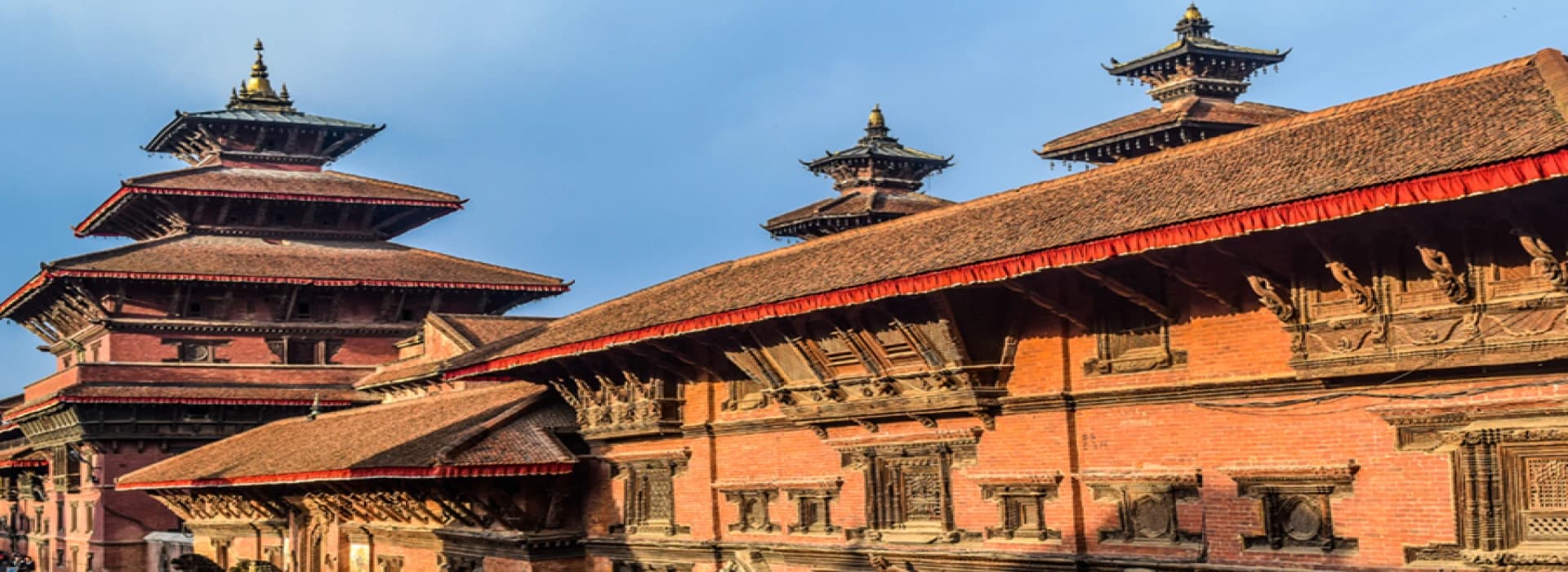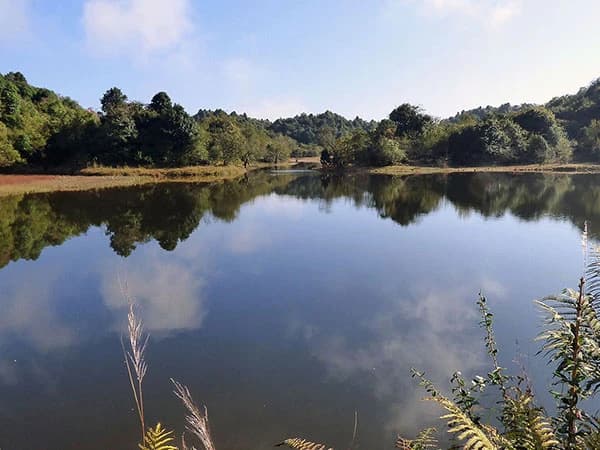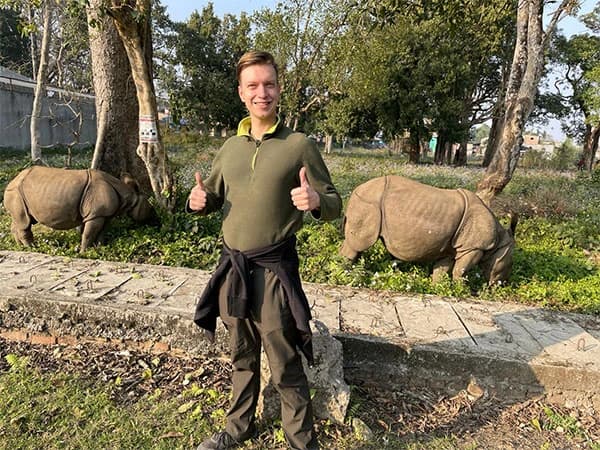This tour was a balance of spiritual sites and breathtaking scenery. The visit to Boudhanath Stupa and Swayambhunath Temple was
If you are looking to cover all the heritage sites of Kathmandu in a short time, then this two-day Tour around Kathmandu is for you.
The 7 UNESCO Heritage Sites Tour (only two days) is a great way to immerse yourself in centuries of arts, culture, and traditions, collected from the Kathmandu Valley. This tour provides a wonderful chance for travelers to enjoy the rich culture and amazing architecture of the most popular sites of Nepal in minimal time in Kathmandu.
Everyone has heard of the seven UNESCO World Heritage sites identified in the Kathmandu ValleySwayambhunath Stupa, Boudhanath Stupa, Pashupatinath Temple, Kathmandu Durbar Square, Patan Durbar Square, Bhaktapur Durbar Square, and Changu Narayan Temple. This exclusive package highlights each of these seven awe-inspiring sites, connections to Nepal's spiritual and historical identity, both as former royal palaces to revered Hindu temples and stupas.
During your visit, our expert guides will share stories about the art, history, and lore of each site so you can understand what is unique about the rich Hindu and Buddhist culture of Nepal. Also, you will be walking through small medieval streets, marveling and taking in the local life and traditional architecture a wonderfully educational adventure.
Your two-day UNESCO Heritage Sites Tour guarantees that you will not miss any of the exquisite cultural treasures of Kathmandu, offering comfortable transport and a tour guide to accompany you. This package is suited for the history lover, photographer, or curious traveler, and will guarantee to provide you with an experience you will never forget.
At Ammonite Adventure, we can put this UNESCO Heritage Sites tour together any time of year, and you can book it right now, even as last-minute as you'd like. You can also easily meld this tour before or after one of the most popular treks in Nepal, such as Everest Base Camp, Manaslu Circuit, Annapurna Base Camp, or Annapurna Circuit Trek.
We designed the tour to give you the flexibility and comfort to provide you with an amazing cultural experience on your way to your trekking experience. With booking prices beginning at just $100 USD per person, you can book with confidence that you are getting an amazing price point for a trip you will never forget.
Highlights
- You visit and discover all seven of the UNESCO heritage specific sites in the Kathmandu Valley; the three Durbar Squares get their own specific focus (Kathmandu Durbar Square, Patan Durbar Square, and Bhaktapur Durbar Square); four religious heritage sites: (Swayambhunath Stupa, Boudhanath Stupa, Pashupatinath Temple, and Changu Narayan Temple).
- You are guided by a knowledgeable English-speaking guide. They can provide you with a meaningful and valuable context around the history and architecture of the site and its cultural significance.
- There is enough time for you to experience each site at your own pace and stop for a quick refreshment or photo opportunities at points of interest.
- Numerous opportunities for photos, and even an opportunity for a complete view of the Kathmandu Valley from Swayambhunath.
- A peaceful kora (circumambulation) around the cultural site of Boudhanath, along with the beautiful, impressive woodwork of the Durbar squares, and the ancient art of Changu Narayan.
- You will begin to better understand the unique intersection of religious beliefs and traditions of both Hinduism and Buddhism in Nepal. This uniqueness has been played out through architecture, aspects of belief, and ritual aspects of engagement for more than a millennium.
- The pacing is appropriately considered for two days where you will not feel rushed.
- You can visit and explore many of the places of heritage and engage with some of its social monuments.
- It provides you the opportunity to stop, breathe, and be in an amazing place, the Kathmandu Valley.
How To Visit Kathmandu’s all 7 UNESCO Sites in 2026?
Kathmandu has so much to offer that you should plan to spend at least a couple of days in the city. In fact, if you want to see all 7 of the UNESCO World Heritage Sites in the Kathmandu Valley, the best option is a 2-day tour.
You can spend full days exploring temples, squares, and cultural sites in Kathmandu, Patan, and Bhaktapur without feeling rushed, and at your own pace.
If you have less time, we also provide a 1-day UNESCO Kathmandu tour option. The 1-day tour would actually cover all the major UNESCO sites in a more condensed timeframe. Still, this option is valid only for the city of Kathmandu, so it is better for a compressed experience, as you won't include Patan and Bhaktapur.
Both in the 1-day or 2-day tours, you will certainly not miss out on history, art, and culture with a guided tour of these incredible sites.
Fully Guided Experience with Expert Local Guides at Ammonite Adventure
Ammonite Adventure offers a fully guided experience with local knowledgeable guides. All local guides are born and raised in the Himalayas. Many have been trained in their own specific terrain and rich cultural history over many years.
All of our guides are licensed, experienced, and fluent in English (and other languages), capable of interpreting not just the landscape, but the depths of our own country's history and traditions.
Whether you are trekking, sightseeing the city, or on a cultural excursion, our local guides are with you every step of the way. They take care of the logistics and keep you safe. They also enhance each experience with local stories. You can book with Ammonite Adventure and confidently walk through the beautiful landscapes in Nepal with the number one local team you can find.
Who can do a 2 Day Kathmandu UNESCO Tour?
This is a two-day option of the "Seven UNESCO Heritage Tour" suitable for all ages and genders.
The pace is relaxed, and we have built in extra time to explore every site without rushing as the second day has less walking in it. If you would rather complete the whole itinerary in one day, we can speed up the schedule and do this.
Because the walking involved in the full tour is quite extensive, we don't recommend the one-day option for seniors with mobility issues, or for travel using a wheelchair.
This two-day format also makes the full itinerary much more achievable for those who would prefer a more leisurely pace or more time built in. Simply let us know, and our Ammonite Adventure Pvt. Ltd. team will make arrangements to accommodate your wish in the best possible way.
10 UNESCO Heritage Sites and UNESCO Fee 2026 Updated
| Site | Foreign Nationals | SAARC Nationals | Chinese Nationals | Nepali Citizens | Notes |
| Kathmandu Durbar Square | NPR 1000 | NPR 500 | NPR 1000 | Free | Entry fee applies to the Durbar Square area. |
| Patan Durbar Square | NPR 1000 | NPR 250 | NPR 1000 | Free | Includes entry to the main square and museum. |
| Bhaktapur Durbar Square | NPR 1800 | NPR 500 | NPR 500 | Free | Entry fee covers the entire Durbar Square area. |
| Swayambhunath Stupa (Monkey Temple) | NPR 200 | NPR 50 | NPR 200 | Free | Entry fee applies to the stupa area. |
|
Boudhanath Stupa |
NPR 400 | NPR 100 | NPR 400 | Free | Entry fee applies to the stupa area. |
| Pashupatinath Temple | NPR 1000/day | NPR 1000/day | NPR 1000/day | Free | Entry fee applies to the temple premises. |
| Changunarayan Temple | NPR 300 | NPR 100 | NPR 300 | Free | Entry fee applies to the temple area. |
| Patan Golden Temple | NPR 100 | NPR 50 | NPR 100 | Free | Entry fee applies to the temple area. |
| National Museum, Chauni | NPR 150 | NPR 50 | NPR 150 | NPR 25 | Entry fee applies to the museum. |
| National Art Museum, Bhaktapur | NPR 150 | NPR 50 | NPR 150 | NPR 25 | Entry fee applies to the museum. |
Important Notes on 7 UNESCO Entrance fee:
- Nepali Citizen Free Entry: Nepali citizens will receive free entry into all of the official UNESCO World Heritage Sites.
- Student Discount: Students can enter some sites with a reduced fee, but students will have to present a valid student identification.
- Group Discount: Some UNESCO World Heritage Sites will provide a group discount; again, I suggest checking ahead of time.
- Purchasing Tickets/Entry: Tickets must be purchased on entry to each site and they cannot be purchased ahead of time online as some sites do not have that option.
- Entry Period: Certain sites (like Pashupati) will allow you to enter the site with an entry fee for the day; therefore, you can enter and exit throughout the day as many times as you desire.
- Prices can change for tickets; please check for current prices at the sites or at the related governing body of tourism and sites.
What places will you visit during the 2-day 7 UNESCO heritage sites tour?
1. Kathmandu Durbar Square
The palace complex (also called Hanuman Dhoka) of the old royal family is in central Kathmandu. It housed the Malla and Shah kings for generations. It is now Kathmandu Durbar Square, full of temples, courtyards, and museum rooms of the royal family.
Inside/around places:
- Kumari Ghar (observing the Living Goddess from the window)
- Taleju Temple (a very tall temple within the square, dedicated to the royal goddess)
- Shiva Parvati Temple (a small temple with the figures of Shiva and Parvati on its roof)
- Gaddi Baithak (a neo-classical palace built in 1908 inside the square)
- Kal Bhairav Statue (a large stone image of the fierce form of Shiva)
2. Swayambhunath Stupa (Monkey Temple)
Located on a hill west of central Kathmandu, this is an ancient Buddhist and Hindu complex. It has the famous white stupa depicting the “all-seeing eyes” of Buddha. It also offers breathtaking views of the valley.
Inside/around places:
- Main bright white hemispherical stupa with gilded spire (the focal monument)
- Buddhist shrines and monasteries around the stupa platform.
- The monkeys that live in the hillside complex (thus “Monkey Temple”) – not a temple for the monkeys, but a part of the experience.
- A viewpoint over the Kathmandu Valley from the hilltop location.
3. Boudhanath Stupa
Among the largest spherical stupas in the world, this Buddhist pilgrimage site is approximately 11 km from central Kathmandu. Tibetan monasteries encircle it. The site is very atmospheric with prayer wheels and flags.
Inside/around places:
- Enormous white dome and the golden spire featuring Buddha eyes – the stupa itself.
- Nearby Tibetan monasteries (e.g., Guru Lhakhang Monastery) and shops selling Tibetan-style thangka paintings, handicrafts, and singing bowls.
- The walking “kora” path around the stupa (circumambulation by pilgrims) – the visitor can join in.
4. Pashupatinath Temple
Pashupatinath is the most holy Hindu temple complex in Nepal, consecrated to the deity Shiva, along the banks of the Bagmati River. It is now a pilgrimage site and has open-air cremation ghats along the river.
Inside/around places:
- The main pagoda-style Pashupatinath temple (Note: Only Hindus can visit the inner sanctum).
- Aryaghat cremation site along the Bagmati River, where you can witness open public funeral rites.
- There are smaller shrines around the area; for example, Guhyeshwari Temple (dedicated to the goddess, Adi Shakti), and other temples like Gorakhnath Temple and Ram Temple were indicated as points of interest.
5. Patan Durbar Square (Lalitpur)
The regal palace complex of the ancient, now called Lalitpur (or Patan), "City of Fine Arts." The square represents the beautiful workmanship of Newari work, temples, courtyards, and the well-known museum.
Inside/around places:
- The square contains the Krishna Mandir (A stone temple constructed in the 17th century in the Shikhara style).
- The Patan Museum (consisting of the former royal palace with sacred art and examples of bronze casting).
- Hiranya Varna Mahavihara ("Golden Temple", Buddhist monastery nearby).
- The courtyards of the palace area, Keshav Narayan Chowk.
6. Bhaktapur Durbar Square
This square, located in the city of Bhaktapur (about 13 km east of Kathmandu), is often termed "a living museum" of Newari medieval architecture, monasteries, and temples, and artisan tradition. [31]
Inside/around places:
- 55-Window Palace (Pachpanna Jhyale Durbar) - celebrated for its 55 beautifully carved wooden window frames.
- The Nyatapola Temple (the five-layered pagoda - the tallest pagoda in Nepal) is in the adjacent Taumadhi Square complex.
- Golden Gate Bhaktapur (the Swarna Dhwākā gate): Entrance to the palace complex decorated with ornate gilded metal-work.
- Dattatreya Temple (temple to the Hindu trinity; older, Dattatreya Square complex)
7. Changu Narayan Temple
On a hilltop (in Dattapethal VDC, Bhaktapur District), this is one of the oldest Hindu temples still standing in the Kathmandu Valley, built in the fourth century AD for Lord Vishnu.
Inside/around places:
- The main pagoda-style temple (on the hill of Changu / Dolagiri) is dedicated to Vishnu.
- Some ancient stone inscriptions and wood-carved decorations, especially the stone inscription of King Manadeva (fifth century), and beautifully carved struts and statues.
- The 'Changu Museum' displays artifacts such as old dish racks, rhino-skin shields, and other curiosities in the nearby complex.
7 World Heritage Sites Tour of Kathmandu Cost 2026, 2027
The package starts at $100 per person and varies with the group size. The price is $180 for an individual traveler (1 pax), then $120 if your group size is 2-4 people, and drops to $100 per person if you are in a group size of 5-10. You get great value for the entire cultural experience.
This tour package will have all-inclusive services under the expertise of a professional tour guide, transportation between attractions, and represents a great opportunity for travelers who want to visit Kathmandu Valley heritage at ease for 2026-2027.




